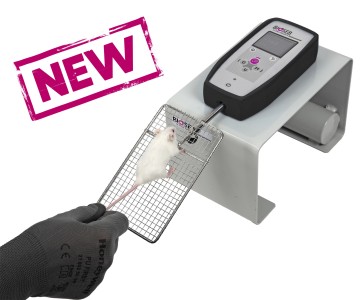Authors
K. L. Lambertsen, J. B. Gramsbergen, M. Sivasaravanaparan, N. Ditzel, L. M. Sevelsted-Møller, A. Oliván-Viguera.
Lab
University of Southern Demark, Odense, Denmark.
Journal
PLoS ONE
Abstract
Background
The calmodulin/calcium-activated K+ channel KCa3.1 is expressed in red and white blood cells, epithelia and endothelia, and possibly central and peripheral neurons. However, our knowledge about its contribution to neurological functions and behavior is incomplete. Here, we investigated whether genetic deficiency or pharmacological activation of KCa3.1 change behavior and cerebral monoamine levels in mice.
Methodology/Principal Findings
In the open field test, KCa3.1-deficiency increased horizontal activity, as KCa3.1−/− mice travelled longer distances (≈145% of KCa3.1+/+) and at higher speed (≈1.5-fold of KCa3.1+/+). Working memory in the Y-maze was reduced by KCa3.1-deficiency. Motor coordination on the rotarod and neuromuscular functions were unchanged. In KCa3.1−/− mice, HPLC analysis revealed that turn-over rates of serotonin were reduced in frontal cortex, striatum and brain stem, while noradrenalin turn-over rates were increased in the frontal cortex. Dopamine turn-over rates were unaltered. Plasma catecholamine and corticosterone levels were unaltered. Intraperitoneal injections of 10 mg/kg of the KCa3.1/KCa2-activator SKA-31 reduced rearing and turning behavior in KCa3.1+/+ but not in KCa3.1−/− mice, while 30 mg/kg SKA-31 caused strong sedation in 50% of the animals of either genotypes. KCa3.1−/− mice were hyperactive (≈+60%) in their home cage and SKA-31-administration reduced nocturnal physical activity in KCa3.1+/+ but not in KCa3.1−/− mice.
Conclusions/Significance
KCa3.1-deficiency causes locomotor hyperactivity and altered monoamine levels in selected brain regions, suggesting a so far unknown functional link of KCa3.1 channels to behavior and monoaminergic neurotransmission in mice. The tranquilizing effects of low-dose SKA-31 raise the possibility to use KCa3.1/KCa2 channels as novel pharmacological targets for the treatment of neuropsychiatric hyperactivity disorders.
BIOSEB Instruments Used
Grip strength test (BIO-GS3)
Source :
http://www.plosone.org/article/info%3Adoi%2F10.1371%2Fjournal.pone.0047744

 Douleur - Allodynie/Hyperalgésie Thermique
Douleur - Allodynie/Hyperalgésie Thermique Douleur - Spontanée - Déficit de Posture
Douleur - Spontanée - Déficit de Posture Douleur - Allodynie/Hyperalgésie Mécanique
Douleur - Allodynie/Hyperalgésie Mécanique Apprentissage/Mémoire - Attention - Addiction
Apprentissage/Mémoire - Attention - Addiction Physiologie & Recherche Respiratoire
Physiologie & Recherche Respiratoire




































 Douleur
Douleur Système Nerveux Central (SNC)
Système Nerveux Central (SNC)  Neurodégénérescence
Neurodégénérescence Système sensoriel
Système sensoriel Système moteur
Système moteur Troubles de l'humeur
Troubles de l'humeur Autres pathologies
Autres pathologies Système musculaire
Système musculaire Articulations
Articulations Métabolisme
Métabolisme Thématiques transversales
Thématiques transversales Congrès & Meetings
Congrès & Meetings 